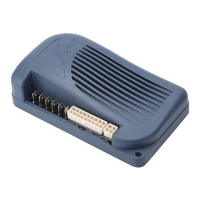12
Curtis 1228 Manual, Rev. F
Speed Limit Pot
A speed limit pot allows the operator to adjust the speed of the vehicle at full
throttle. The speed limit pot should be sized so that it does not affect throttle
input resistance and thus the throttle response; a 100k
Ω pot is recommended.
Wiring is shown in the basic wiring diagrams (Figures 3a/3b and 4a/4b).
The speed limit pot is at its maximum speed setting when its wiper is
shorted to the throttle pot’s pot high connection (Pin 3). When the speed
limit pot is in its maximum speed position, the vehicle’s speed at full throttle
corresponds to the programmed maximum speed setting
.
The speed limit pot is at its minimum speed setting when its wiper is
shorted to the throttle pot’s pot low connection (Pin 13). When the speed
limit pot is in its minimum speed position, the vehicle’s speed at full throttle
corresponds to the programmed minimum speed setting. For information on
the programmable speed parameters, see Section 3.
The speed limit pot varies the vehicle’s speed linearly over the range be
-
tween the minimum and maximum speed settings in each mode.
The speed limit pot also limits the vehicle’s reverse speed. Reverse speed
is linearly proportional to the speed limit pot setting and is adjustable from
the programmed maximum reverse speed (maximum reverse speed with speed
limit pot in its
maximum speed position) to the programmed minimum reverse
speed (maximum reverse speed with speed limit pot in its
minimum speed
position).
If a speed limit pot is not used, the speed limit input (Pin 18) should
be jumpered to the pot high output (Pin 3). In this configuration, the vehicle
speed at full throttle is defined by the programmed maximum speed. If no jumper
is used, the vehicle speed at full throttle will be limited to the programmed
minimum speed, and the controller will register a speed limit pot fault.
SWITCHES AND OTHER HARDWARE
Keyswitch
The vehicle should have an OEM-supplied master on/off switch to turn the
system off when not in use. The keyswitch provides logic power for the control
-
ler and for the other control input switches. It must be sized to carry the 150
mA quiescent logic current plus the current necessary to drive the precharge
function (1.5 A for 0.5 seconds) and the status LED, horn, and any other ac-
cessories powered from the keyswitch circuit.
Push Switch
A push switch can be used to electrically release the electromagnetic brake, so
that the vehicle can be pushed. Activating the push input inhibits the controller’s
drive functions until the push switch is turned off.
The push switch must go from off to on while the vehicle is stopped; if
the push switch is turned on while the vehicle is moving, the electromagnetic
2 — INSTALLATION & WIRING: Switches, etc.

